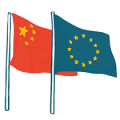

China seems to tone down its 16+1 engagement: three possible explanations
News that China plans to reduce the frequency of its summits with Central and Eastern European countries has been interpreted as a charm offensive towards Brussels, where many see the 16+1 as divisive. But it could also be an acknowledgment that many of China’s economic promises to the region have not materialized or even an attempt to further divide Europe.
“China may pare back 'divisive' eastern Europe summits,” Reuters reported on Monday, referring to Beijing’s annual summits with 16 Central and Eastern European countries (CEEC), which include both EU member states and neighbourhood countries. The format has received close scrutiny from Brussels ever since its creation in 2012. China now seems to be delaying the next meeting scheduled for 2018 in the Bulgarian capital of Sofia amidst concerns that the high-level symbolic cooperation under the format might undermine its relations with the EU.
The Reuters article quoted a senior EU official as saying that the 16+1 framework will keep existing, “but it will be a less intensive format, probably shifting more to bilateral talks.” European diplomats also said that China might shift the current annual basis of the summits gathering 16+1 heads of government into a biannual format. Three – potentially overlapping – lines of reasoning might explain why China has decided to tone down its 16+1 engagement.
Explanation 1: China prioritizes good relations with the entire EU
EU officials quoted in the Reuters article seem to interpret this development as a response to criticism of the format coming from other parts of Europe. Lately, concerns about the 16+1 format saw a revival in Brussels and some Western European states, increasingly creating an image problem for China. Beijing might have decided that it was high time to address this issue – not least in light of the EU moving forward with its proposal for a new pan-European investment screening mechanism, which is primarily directed at Chinese state-led acquisitions in Europe.
The overall success of China’s global trade and infrastructure plan and Xi Jinping’s flagship foreign policy project, the Belt and Road Initiative (BRI), very much depends on favorable perceptions and support of countries involved. As such, Beijing needs to take care of its reputational capital, and the move to tone down its 16+1 engagement might be a step in this direction.
Explanation 2: China does some housekeeping
Another plausible explanation is that China might want to address an emerging expectations-capability gap that has become visible in the 16+1 context. Annual summits have created high expectations in the region, but many of Beijing’s promises for investment and infrastructure financing in CEEC have failed to materialize.
Flagship BRI projects in the CEEC, such as the Belgrade-Budapest railway, were put on hold in light of non-compliance with EU legislation. Comprising of only one bridge in Serbia and one motorway in Macedonia the list of China-financed 16+1 infrastructure construction projects completed as of late 2017 is rather short. China’s own official data suggests that as of June 2017 roughly EUR 6.7bn of FDI had flown into CEE industries, including into machinery equipment manufacturing, chemicals, telecoms and new energies. Taking into account the size and output of CEE economies, the investment is significant, but it pales when compared to Chinese investments in Western EU member states. Between 2000 and 2016, Germany alone saw an inflow of EUR 18.8bn of Chinese FDI. To date, the 16+1 China-CEE investment cooperation fund has failed to complete a single sizeable transaction.
Explanation 3: China seeks to deepen divisions within Europe
Ultimately, there could also be a more “sinister” explanation as to why Beijing considers toning down its engagement within the 16+1 framework. Several CEE EU member states will be quick to blame the shift on larger member states, like France and Germany, for having spoiled their special ties with China within the 16+1 framework. Reportedly, sources close to the Polish government expressed dismay over “old Europe’s” attempt to weaken the 16+1 format. Part of the CCP’s strategic calculus in downgrading the 16+1 format might be to further kindle existing political cleavages between the cash-strapped CEEC economies and the rest of the Union and to further weaken Europe’s ability to find a consensus on how to best engage a politically and economically more assertive China.
While, in the past, the Xi Jinping administration has left no doubt that it is interested in the persistence of a consolidated European single market, it might eventually be willing to sacrifice this goal in return for support from individual EU member states and neighborhood countries for its own political model and foreign policy goals.
The EU should seize the moment
Rather than second-guessing Beijing’s motives for changing its 16+1 policy, decision-makers in Brussels and in EU member states, like France and Germany, should seize the moment and seek greater alignment of EU member states’ China policies. Expediting the implementation of existing plans in Brussels for a new EU connectivity initiative for Europe seems a timely venture, as more CEEC come to terms with the sobering realties of China’s economic engagement in the region. Brussels also needs to popularize the message among opinion multipliers in CEE EU member states and EU neighborhood countries that so far China has not lived up to its ambitious financing and investment rhetoric and that Chinese activities are a long way away from matching what the EU has put on the table to date.
At the same time, Germany and France must continue to build a stronger pan-European perspective into their bilateral policies towards China. Both German Chancellor Angela Merkel and French President Emmanuel Macron recently pointed out the importance for European companies to get better access to the Chinese market. They also warned about the risks of state-driven Chinese takeovers of European high-tech companies.
CEEC governments, however, do not consider these issues priorities. They hope that Chinese investment will give their economies a push, and that closer relations with Beijing will increase their leverage vis-à-vis Brussels. It is up to Germany and France to initiate a focused debate among the greatest possible number of EU member states over the corner stones of a European China policy that takes everybody’s interests into account. Recent expressions of concern by Angela Merkel about China’s growing political influence in Europe will hopefully translate into a China policy that is more inclusive of Europe-wide interests.


